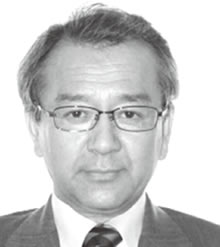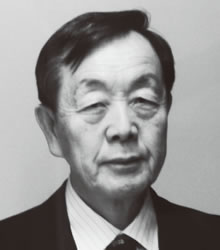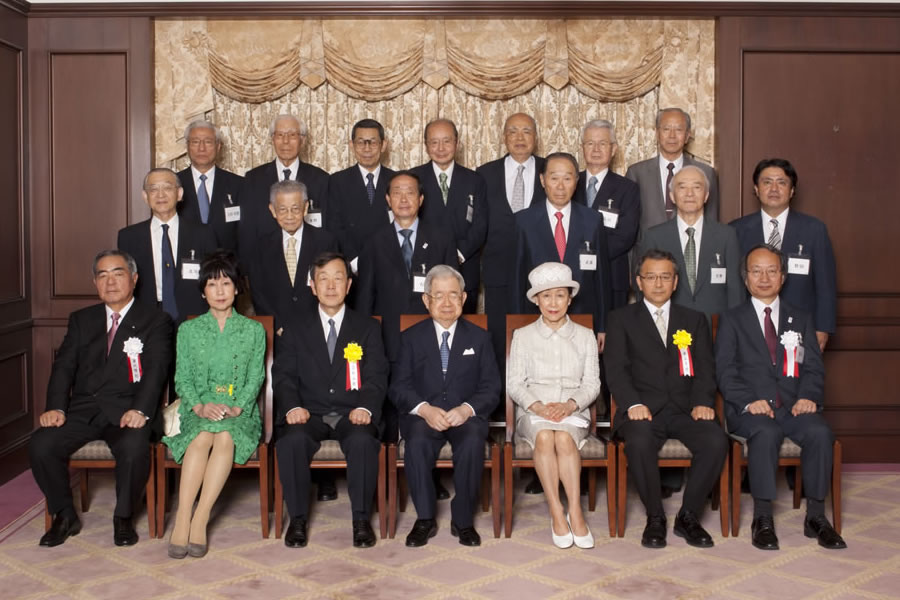The Awardee of the 2013 Prince Hitachi Prize for Comparative Oncology
"Establishment of the Mongolian gerbil infection model and elucidation of H. pylori-induced promotion of gastric carcinogenesis"
 Dr. Fumihiro Hirayama
Dr. Fumihiro Hirayama
Principal Research Scientist
Central Research Laboratory
Japan Blood Products Organization
略歴
平山博士は、1980年、九州大学農学部発酵化学課程を修了し、吉富製薬(現:田辺三菱製薬株式会社)入社、微生物の生産する生理活性物質や抗菌剤の研究に従事していた。入社後に順天堂大学医学部細菌学教室の故横田健名誉教授や東邦大学医学部微生物学教室の五島瑳智子名誉教授の研究室へ国内留学し、in vitroからin vivoにわたる細菌学を学んだ。1988年、博士は米国化学療法学会で“胃潰瘍の原因は、ヘリコバクターピロリ(ピロリ菌)である”との研究発表に接し、抗ピロリ薬の開発を目指して研究を開始した。しかしながら、多くの論文に見られるように、通常のマウスやラットを使った実験ではピロリ菌が持続感染せず、また感染しても病的変化は認められず、動物実験モデルは確立できなかった。研究を開始して数年後に、博士はスナネズミを用いた論文に注目し、マウスやラットに比べて高価だったスナネズミを3匹購入して新たな実験を開始した。はじめはなかなか成功しなかったが、ピロリ菌の培養法や感染方法に工夫を重ね、遂にピロリ菌の持続的な感染モデルを確立した。ピロリ菌の研究を開始して6年後の1994年夏、平山博士は、ピロリ菌を接種して3ヶ月を経過したスナネズミの胃に、炎症性の変化に続いて肉眼的に明らかな円形の潰瘍が発生することを確認した。これら一連の成果は、日本ヘリコバクター学会や日本実験潰瘍学会で発表され、注目を受けた。1995年8月、当時のピロリ菌研究の権威である故下山孝兵庫医科大学名誉教授(当時のヘリコバクター学会理事長)、藤岡利生大分医学部教授および勝山努信州大学医学部教授の3人が研究所を訪問した。3名の面前で、平山博士は感染したスナネズミを解剖し、4匹中3匹のスナネズミに肉眼的に明らかな潰瘍が発生していることを示した。教授達が息を飲んで驚嘆した様子を、博士は今でもよく覚えているという。この時を契機に、スナネズミを用いたピロリ菌感染モデルが認知され、その後内外の多くの研究者により、本感染モデルが多方面の研究に活用されるようになったのである。
博士の業績に対して、1995年に第1回日本ヘリコバクター研究会会長賞、1997年に第25回日本実験潰瘍学会奨励賞また2007年に第36回高松宮妃癌研究基金学術賞が贈られた。
平山博士は、2007年に不運にも多発性骨髄腫に罹患したが、新薬が著効を示して完全寛解となり研究生活に復帰した。細菌と付き合い始めて35年、今後も淡々と研究生活を続けると語っている。
Personal History Outline
Dr. Fumihiro Hirayama completed his master's course in Applied Microbiology at the Faculty of Agriculture of Kyushu University in 1980 and joined Yoshitomi Pharmaceutical Company (now Mitsubishi Tanabe Pharma Corporation) where he was engaged in research on bioactive substances produced by bacteria and antibacterial agents. He also had opportunities to study in the laboratories of the late Takeshi Yokota (Emeritus professor of the Department of Bacteriology at Juntendo University) and Sachiko Gotoh (Emeritus professor of Department of Microbiology, Faculty of Medicine at Toho University) and during the period spent in those labs, he gained extensive knowledge and skills related to in vitro and in vivo techniques in bacteriology.
In 1988 at the Interscience Conference on Antimicrobial Agents and Chemotherapy, Dr. Hirayama came across a presentation, demonstrating that Helicobacter pylori (H. pylori) was one of the cause of gastric ulcers. This encounter led him to study the bacteria with the aim of development of anti-H. pylori agents. However, as seen in many published articles, long-lasting H. pylori infection was difficult to achieve by using common species of mice and rats and even if infection was established, no pathological change was observed. Despite all of his effort, the establishment of an animal model for long-lasting gastric infection of H. pylori was not an easy task.
A few years after starting the research, Dr. Hirayama bought 3 Mongolian gerbils which were much more expensive than common species of mice and rats, and started experiments with them. His big challenge of establishing the model began only with those 3 animals.
At first, he found many difficulties in establishing gerbil model of H. pylori infection. However, after having made all kinds of efforts to develop methods for culturing and inoculating the bacteria, he finally found the inflammatory change by continuous infection in the gerbil's stomach. Following that, a round ulcer was observed macroscopically in the stomach at 3 months after H. pylori infection. This achievement was reported at the Annual Meetings of the Japanese Society for Helicobacter Research and the Japanese Society of Ulcer Research and drew a lot of attention.
In August 1995, the late Takashi Shimoyama (Emeritus professor at Hyogo College of Medicine and the chairperson of the Japanese Society for Helicobacter Research), Toshio Fujioka (Professor of the Faculty of Medicine at Oita University), and Tsutomu Katsuyama (Professor of School of Medicine at Shinshu University), all leading authorities on H. pylori study in those days, visited Dr. Hirayama's laboratory. He was honored to perform autopsies on infected gerbils in front of those professors and still remembers their gasps of astonishment when ulcer formation was macroscopically shown in 3 out of 4 animals. After their visit, the gerbil model of H. pylori infection became widely known and used by many domestic and foreign researchers in various fields. For his excellent work, prizes were awarded by the Japanese Society for Helicobacter Research (1995), the Japanese Society for Experimental Ulcer Research (1997) and the Princess Takamatsu Cancer Research Fund (2007).
Although Dr. Hirayama suffered from multiple myeloma in 2007, he overcame it successfully and is now engaged in research on efficient use of donated blood to be a bridge between people's charity and good medical services in the Central Research Laboratory of Japan Blood Products Organization.
The Awardee of the 2013 Prince Hitachi Prize for Comparative Oncology
 Dr. Masae Tatematsu
Dr. Masae Tatematsu
Visiting Researcher
Japan Bioassay Research Center
Japan Industrial Safety & Association
略歴
立松正衞博士は、1971年名古屋市立大学医学部を卒業後、同大学の第1病理学講座の大学院生として、胃がんの研究を開始した。その時までに博士は、2000種以上の三葉虫を所有する世界的な三葉虫のコレクター・研究者でもあった。研究開始まもなく、杉村隆博士から-アフリカツメガエルの胃はヒトの胃と異なる-と教示され、古生物学の視点より消化管の系統発生の研究を進め、小腸の幹細胞は4億5000万年以上保たれてきたが、胃の幹細胞は約1〜1.5億年のサイクルで大改変が繰り返された事を明らかにした。常陸宮様からご提供していただいた肺魚の胃の検索が、この研究の進展に大きく貢献した。
1975年に、食塩の胃がん発生におけるプロモーション作用を実験的に証明した。ほぼ同時期に、杉村博士および降旗千恵博士との胃がんとペプシノーゲンについて共同研究がスタートし、胃型胃癌、腸型胃癌の概念の基礎を確立した。また、勝山努博士との共同研究により、ラット実験胃癌で発生する胃癌は胃型の癌細胞で構成され、腸型胃がんは腸上皮化生から独立して発育進展する事を示した。伊東信行先生の尽力により1985年から2年半トロント大学に留学し、E. Farber博士のもとで実験病理学の研鑽に努めた。トロント近郊は世界的に知られた古生代オルドビス紀の三葉虫の産地でもあり、週末は三葉虫の採集を楽しんだ。1990年より愛知県がんセンター研究所の腫瘍病理部長となり、C3H系統特異抗体によるキメラマウスの実験胃癌の研究を開始、癌は多分化能を持つ一個の細胞から発生し、胃癌の進展に伴い胃癌細胞分化が2次的に発生することを明らかにした。
1998年、立松博士は、平山文博博士のスナネズミのHelicobacter pylori (H. pylori) 感染モデルに基づき、H. pylori感染スナネズミ腺胃化学発癌モデルを確立した。このモデルにより、H. pyloriは胃癌の直接原因というよりは強力な胃癌促進要因で、その除菌や食塩の摂取の減量は、胃癌の発育・進展を効果的に抑制することを明らかにした。加えて、マウス、ラット、スナネズミの化学発癌物質による胃癌発生では腸上皮化生と腸型胃癌は発生しない、H. pyloriが感染したスナネズミ腺胃発がんモデルにおいてのみ腸上皮化生や腸型胃癌が発生する、H. pyloriは腸上皮化生や腸型胃癌発生の決定的な要因であること等々を明確にした。これらの研究業績により、博士は2002年に日本病理学賞、2005年に読売東海医学賞、2007年に高松宮妃癌研究基金学術賞を受賞した。
博士は現在、H. pyloriが腸上皮化生や腸型胃癌の発生にどのように関わっているか研究を進めている。
Personal History Outline
Dr. Masae Tatematsu graduated from Nagoya City University Medical School in 1971. He became a postgraduate in its 1st Department of Pathology and started his research works covering gastric carcinogenesis. By that time he was already a world- renowned trilobite collector and researcher owning more than 2000 species of them. Early in his career, Dr. Takashi Sugimura informed him that the structure of the stomach of the Xenopus laevis (African Clawed Frog) differed from that of the human stomach. Led by this information, he advanced research on the phylogeny of the alimentary canal and discovered that, although small intestinal stem cells have been maintained for over 450 million years, the stem cells of the stomach changed at intervals of about 100 million to 150 million years. Examinations of the lungfish stomach offered by Prince Hitachi contributed greatly to the progress of this research.
In 1975, Dr. Tatematsu showed that sodium chloride promotes stomach carcinogenesis. At about the same time, a joint research work on stomach cancer and pepsinogen was started with Drs. Sugimura and Chie Furihata. They established the foundation of the concept of gastric-type and intestinal-type carcinoma of the stomach. With the joint research of Dr. Tsutomu Katsuyama, Dr. Tatematsu showed that gastric adenocarcinomas induced by chemical carcinogens in rats were composed mainly of the gastric type tumor cells and that ones of intestinal type developed with time independently from intestinal metaplasia. For two and a half years starting in 1985, he studied at the University of Toronto through the efforts of Dr. Nobuyuki Ito. While at this university, he advanced research on experimental pathology under the auspice of Dr. E. Farber. The suburbs of Toronto are world-renowned for their Ordovician trilobite fauna. He enjoyed collecting trilobites on the weekend. In 1990, Dr. Tatematsu became head of the Division of Oncological Pathology, Aichi Cancer Center Research Institute and began research on stomach cancers developing in chimera mice. Using antibodies strictly recognizing C3H strain specific antigens, he was able to clarify that cancers were derived from single cells with multi-potential activities and that cellular differentiation of gastric cancer cells occurred secondarily.
In 1998, utilizing Dr. Hirayama's Mongolian gerbil (MG) model of Helicobacter pylori (H. pylori) infection, Dr. Tatematsu established animal models of gastric carcinogenesis using MG treated with MNU(chemical carcinogen) as initiator and clarified the following; 1) H. pylori is not an initiator, but rather a strong promoter of gastric carcinogenesis whose eradication, together with reduction in salt intake, effectively prevent gastric cancer development. 2) Neither the intestinal metaplasia nor the intestinal-type gastric carcinomas are induced in the stomach of rats, mice and MGs treated with chemical carcinogens only but they emerge when there are both a carcinogen and H. pylori infection. H. pylori was therefore considered to be a definite factor to induce the intestinal metaplasia and the intestinal-type gastric carcinoma.
For those excellent achievements, Dr. Tatematsu was given an award by the Japanese Society of Pathology in 2002, and received the Yomiuri-Tokai Award in 2005 and the Princess Takamatsu Cancer research Fund Award in 2007.
Currently he is investigating how H. pylori induces intestinal metaplasia and intestinal-type gastric carcinoma.
研究業績
1983年にJR WarrenとBJ Marshall両博士がHelicobacter pylori(ピロリ菌)を発見、Dr. Marshallは培養した菌を自ら服用して、これが急性胃炎の原因菌であることを証明した。その後、ピロリ菌感染が慢性胃炎を経て胃がんを生じる原因となることを示す疫学的事実が蓄積し、IARCは1994年にピロリ菌を胃がんのdefinite carcinogenであると結論した。しかしながら、ピロリ菌の胃がん発生への関与とその機序は、1996年から数年間の、平山文博と立松正衛両博士らの動物実験により、初めて証明されたのである。Warrenと Marshall両博士は、2005年に彼らの発見によりノーベル賞を受賞した。
ピロリ菌は、サルなどの大動物を除いて、通常の実験動物の胃に持続的に感染させることは困難で、それまで動物実験の壁となっていた。1996年に、平山博士はMongolian gerbil(スナネズミ)の胃にピロリ菌が持続的に感染し、高度の急性胃炎、潰瘍および慢性胃炎を生じることを発見、ピロリ菌持続感染の動物モデルを樹立して、その突破口を拓いた。
立松博士は、平山博士のスナネズミモデルを用い、N-methyl-N-nitrosourea などの化学的がん原物質によるイニシエーション後の胃発がん発生に及ぼすピロリ菌持続感染の影響を調べ、以下の事実を明らかにした。1)ピロリ菌の持続感染は、がん原物質による胃がん発生をプロモートする。その効果は、すでに立松博士が明らかにしていた食塩のプロモーション効果よりも強い。2) 食塩を同時に投与すると、ピロリ菌と食塩の加算効果が見られる。 3) イニシエーション後に除菌すると、がんの発生率は著しく減少する。4)イニシエーションなしのピロリ菌持続感染は、漿膜にまで達する胃線管の異所性侵入を含む高度の胃炎を生じるが、これらの変化は除菌により消失する。
現在までに、ピロリ菌感染が胃がんの最大の原因であり、また除菌が胃がんの有効な予防手段であることが確実となり、厚労省は近々、ピロリ除菌を(従来のように潰瘍を伴う場合に限定せず)全面的に保険適用とする方針を決めたが、この重要な決定に、平山・立松両博士の動物実験の結果は大きな力となったのである。
Academic Achievement
In 1983, Drs. JR Warren and BJ Marshall identified Helicobacter pylori (HP) and Dr. Marshall proved that it was the causal factor of acute gastritis by drinking the bacteria himself. With the accumulating epidemiologic evidence, in 1994 the IARC recognized HP as a definite carcinogen of human gastric cancer. However, the carcinogenicity of HP was first proven experimentally by Drs. F. Hirayama and M. Tatematsu between 1996 and 1998. Drs. Warren and Marshall were awarded the Nobel prize for their discovery in 2005.
Until 1996, it had been difficult to infect laboratory animals with HP over a long period, and that had been the barrier for animal experiments. In 1996, Dr. Hirayama discovered that the Mongolian gerbil was sensitive to HP and established an animal model for long-lasting HP gastric infection which caused acute / chronic gastritis and gastric ulcers. This was a breakthrough.
Utilizing Dr. Hirayama's Mongolian gerbil model, Dr. Tatematsu studied the effect of long-lasting HP infection on gastric carcinogenesis after initiation by chemical carcinogens including N-methyl-N-nitrosourea and clarified the following matters: 1) long-lasting HP infection promoted the carcinogen-initiated gastric carcinogenesis, the effect being stronger than that of salt, the promotive action of which had earlier been revealed by himself; 2) simultaneous treatment with salt and HP showed a summation effect of promotion; 3) eradication of HP after initiation resulted in a remarkable reduction of cancer incidence; and 4) long-lasting HP infection without initiation induced marked gastritis including heterotopic infiltration of gastric glands down to the serosa, but those changes disappeared after HP eradication.
Since it is now certain that HP infection is the largest causal factor of human gastric cancer and that its eradication is the most effective way of cancer prevention, the Japanese Ministry of Health, Labor and Welfare has recently removed all previous restrictions and decided to fully cover HP eradication under the medical insurance system. The results of the experiments by Drs. Hirayama and Tatematsu had an impact on the governments making of this important decision.


